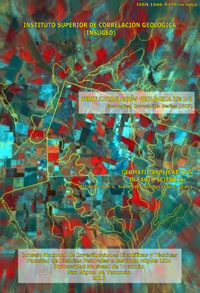Serie Correlación Geológica 33
Uranium exploration through the integration of Multispectral Imagery, Radar and Field Radiometry at the Laguna Sirven Project, Province of Santa Cruz
Talía C. Berg | Pablo J. Echevarria | Guillermo E. Re Kühl
Descargar trabajo en formato PDFResumen
EXPLORACIÓN DE URANIO MEDIANTE LA INTEGRACIÓN DE IMÁGENES MULTIESPECTRALES, RADAR Y RADIOMETRÍA DE CAMPO EN EL PROYECTO LAGUNA SIRVEN, PROVINCIA DE SANTA CRUZ. En la presente publicación se detallan los trabajos realizados para la delimitación de anomalías uraníferas en el Proyecto Laguna Sirven, al norte de la Provincia de Santa Cruz. En la década del 70 la CNEA realizó estudios orientados a la definición de sectores con potencialidad de mineralización de uranio en las provincias de Santa Cruz y Chubut, entre los que se encontraba este Proyecto. Se trata de un depósito sedimentario formado por precipitaciones ricas en uranio cerca de la interfaz del nivel freático, generando calcretes de gran extensión y forma típicamente tabular. En la mayoría de estos depósitos, el uranio proviene de la meteorización de rocas volcánicas, las cuales podrían ser yacimientos secundarios de uranio. La solubilidad del uranio está estrechamente ligada al potencial de oxidación, por lo cual bajo condiciones oxidantes el uranio se encuentra como catión U6+, altamente soluble y por ende muy móvil. Sin embargo, en un ambiente reductor, el ion U6+ se convierte a la forma insoluble U4+. Así, el uranio en solución circula a través de estratos permeables hasta que se topa con condiciones reductoras y precipita. Geoquímicamente, el uranio es un elemento incompatible, lo cual genera que este elemento sea de los últimos en cristalizar a partir de un fluido magmático. Por consiguiente, se concentra en las rocas ácidas formadas en las últimas etapas de la diferenciación magmática. En el modelo del yacimiento se estima que la fuente primaria de uranio corresponde a las piroclastitas cretácicas de las formaciones Castillo, Bajo Barreal y Laguna Palacios, pertenecientes al Grupo Chubut, y en menor medida las piroclastitas jurásicas del Grupo Bahía Laura. Los estudios realizados mediante sensores remotos se basaron en imágenes multiespectrales LandSat 7 ETM+, ASTER, y Modelos de Elevación Digital a partir de imágenes SRTM. A partir de este set de imágenes se generaron diferentes productos orientados a la delimitación de anomalías minerales y térmicas, patrones de escorrentía, zonas de aporte y depositación. Luego, se realizaron trabajos de campo en la zona, los cuales incluyeron un relevamiento terrestre de radioespectrometría gamma y toma de muestras para análisis geobotánicos. La integración del conjunto de información obtenida en un Sistema de Información Geográfica permitió avanzar con los trabajos exploratorios de uranio en este Proyecto.
Abstract
The present publication details the works carried out for the delimitation of uranium anomalies in the Laguna Sirven Project, north of Santa Cruz Province. During the 70s the CNEA conducted studies aimed at defining areas with potential for uranium mineralization in the provinces of Santa Cruz and Chubut, including this Project. This site corresponds to a sedimentary deposit formed by rich uranium precipitations at the water table interface, creating calcretes of a large extent and typically tabular form. In most of these deposits, uranium comes from the weathering of volcanic rocks, which could be secondary uranium deposits. Uranium solubility is closely linked to oxidation potential, whereby under oxidizing conditions uranium is found as U6+ cation, highly soluble and therefore very mobile. However, in a reducing environment, the U6+ ion is converted into the insoluble form U4+. Thus, the uranium in solution flows through permeable strata until it meets reducing conditions and precipitates. Geochemically, uranium is an incompatible element, which causes it to be one of the latest elements in crystallizing from a magmatic fluid. Therefore, it concentrates in acid rocks formed at the final stages of magmatic differentiation. It is estimated that, in the deposit model, the primary source of uranium is the Cretaceous pyroclastites from Castillo, Bajo Barreal and Laguna Palacios formations, belonging to the Chubut Group, and to a lesser extent the Jurassic pyroclastites from Bahía Laura Group. The studies conducted through remote sensing were based on LandSat 7 ETM+ and ASTER multispectral images, and Digital Elevation Models from SRTM images. Many products were generated from this image data set oriented to the delimitation of mineral and thermal anomalies, runoff patterns, source and deposition areas. Afterward, fieldwork was performed in the area, including a gamma radiospectrometry terrestrial survey and geobotanical sampling. The integration of all the information obtained into a Geographic Information System allowed us to move forward in exploratory works in this Project.






